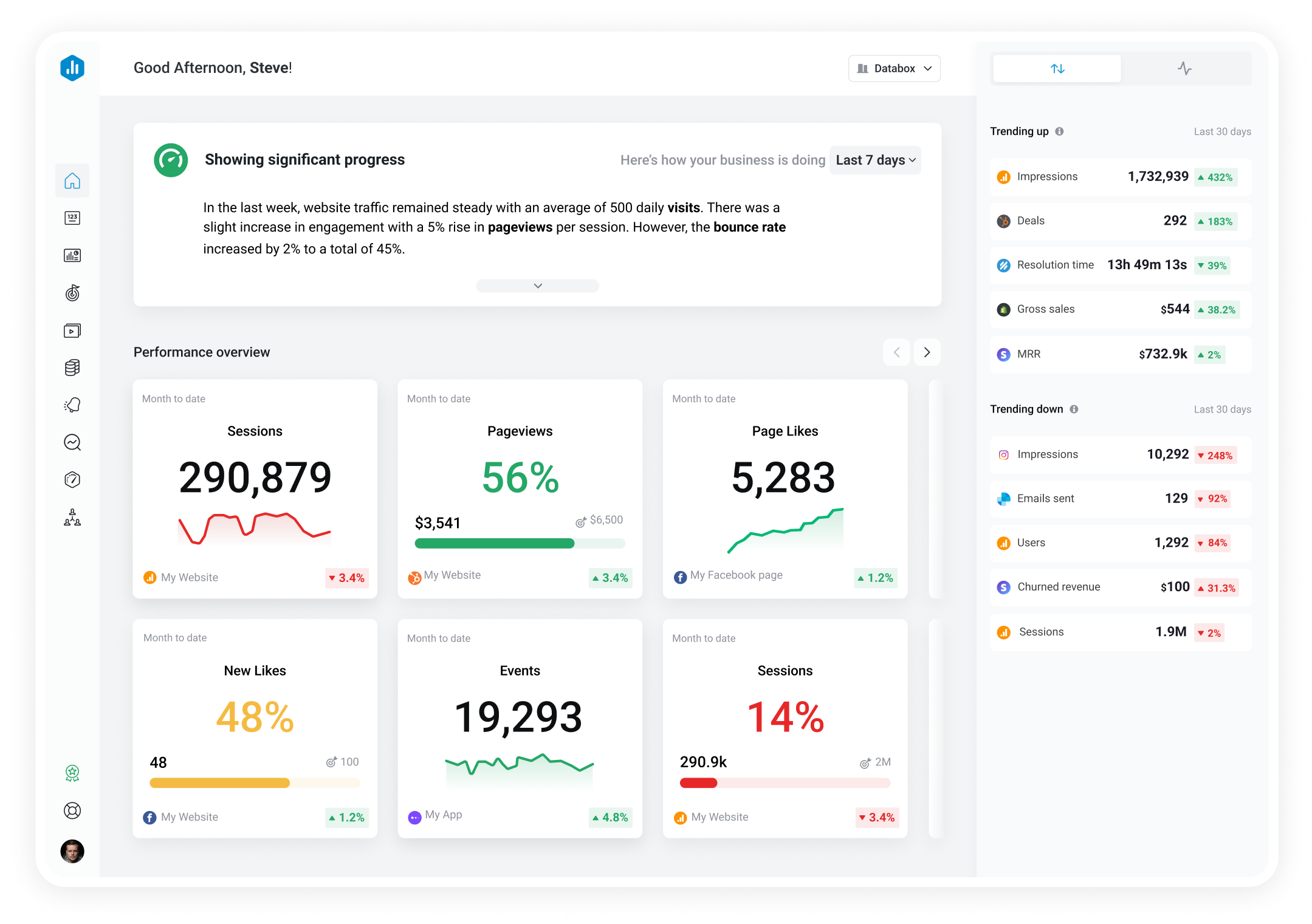Track all of your key business metrics from one screen
GET STARTED

Mailchimp is a popular email marketing platform that allows businesses to create, send, and manage email campaigns. It provides tools for designing attractive emails, managing subscribers, and analyzing campaign performance, making it easy for businesses to reach and engage with their audience effectively.
MailChimp is an email marketing platform, that allows you to send marketing emails, automated messages, and targeted campaigns.
With Databox, your most important MailChimp KPIs will be transformed into meaningful insights and delivered to your mobile, Apple Watch, TV display or Slack channels. One of the key benefits of Databox is the ability to combine multiple data sources in one place. This will help you improve your email marketing efforts.
Show more...
Show more...
Show more...
Users must have an ‘Admin’ or ‘Manager’ role in MailChimp in order to connect MailChimp to Databox.
If user does not have the ‘Admin’ or ‘Manager’ role in MailChimp, the error message ‘Forbidden error’ or ‘User role ‘author’ cannot access this request’ gets displayed in Databox during the connection process.
Currently, it is not possible to sort campaigns by date for the Mailchimp metrics on a Table visualization type, since the sorting is based on the date when the relevant metric was synced. This is because no historical data is available for these metrics and also because all Dimensions are pushed to the exact same date and time. This is a limitation on the API level and on the way that this type of data is pushed to Databox.
There are 2 workarounds that can be used to sort Campaigns by date.
1) You can manually select up to 10 most recent campaigns in the dimension dropdown field on the right side of the screen in the Datablock Editor.
2) You can use a Table with Multiple Metrics and manually sort the campaigns by Date Order. There will be separate tables for each metric that you want to track. The maximum limit of rows in this case is 100.
The campaigns from Mailchimp that do not have a campaign title will not be displayed In Databox.
1. In case a campaign is missing in Databox, follow these steps:
Check the missing campaign’s settings for the campaign title in Mailchimp and compare the settings of the missing campaign with the settings of a campaign that is displayed in Databox. If there are no differences in the settings, please proceed to step 2.
2. Reach out directly to Mailchimp Support. There is a possibility that there is a discrepancy between the Mailchimp User Interface and their API. They can investigate the occurence further and provide a solution if needed.
All MailChimp metrics in Databox are Current Metrics. This means there is no historical data available for the metrics prior to the date they were first used in Databox.
However, data might appear in Databox for some Campaigns for dates prior to the date when the given metric was first used in Databox.
The reason for this is that some Campaign values are synced on the Campaign send date. Since all metrics are Current Metrics, we only receive current data for the metrics and sync it from the current date onwards by design, but in certain exceptional cases, the Mailchimp API can also return some historical data if the Campaigns are synced to the send date.
In MailChimp users often do not set up unique names for Email Campaigns. When syncing this data with Databox, this results in all values for metrics being associated with one Email Campaign.
To ensure accurate reporting for unique Email Campaigns, a timestamp has been added to each Email Campaign Name in Databox. This timestamp represents the date when the Campaign was sent to a specific audience.
Therefore, Email Campaign Names are displayed as follows in Databox:
‘Email Campaign Name (mm/dd/yy hh:mm:ss).’
For example, ‘Spring Stock-Up Sale Reminder (02/02/2020 23:37:29)’ rather than just ‘Spring Stock-Up Sale Reminder’.
In Mailchimp, Campaign data from Databox can be verified by clicking on the Campaigns icon in the lefthand menu under All campaigns. Under each individual Campaign, the ‘Sent’ timestamp has been added to Email Campaign Names in Databox. Campaign create date is visible in the Mailchimp Account. However, in Databox instead of the creation date users can track when a contact opened the email (metric ‘Open Rate by Campaign’).
More information about verifying campaign data is available in the designated Help Article: How to verify Email Campaign data in Databox vs Mailchimp?
Due to API limitations, hourly granularity is not supported for Mailchimp metrics. This may affect visualization options for Charts in Databox.
For example, if a Mailchimp metric is used on a Line or Bar Chart with ‘Yesterday’ Date Range selected, hourly data will not be displayed on the Chart.
However, the Big number (the total value above the Chart) will accurately reflect the Metric value for the selected Date Range.
Learn more about Granularity here.
